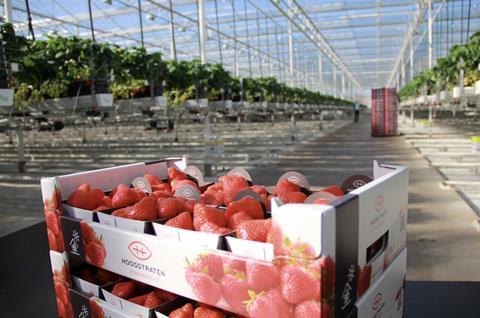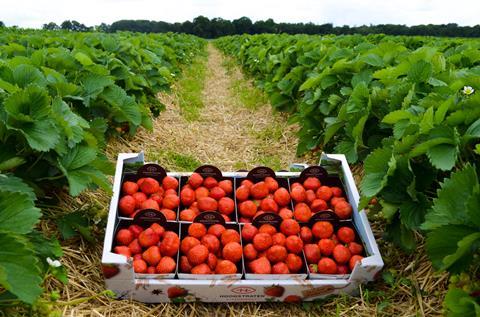Whether it’s selecting the right strawberry varieties, marketing to consumers or overcoming challenges like climate change and high costs, Michiel Vermeiren, business unit manager fruit at Belgian cooperative Hoogstraten, sees cooperation as vital
How are strawberry volumes looking this season at Hoogstraten?
Michiel Vermeiren: Around 34,000 tonnes of Hoogstraten strawberries will reach the market in 2024. Due to the entry of some new members and the expansion of existing growers, this is more than the traditional 30,000 tonnes. Seasonal homegrown fruit is increasingly becoming a quality label itself, and consumers appreciate the delicious taste and authenticity.

What’s the current varietal mix? Which varieties are growing in acreage?
MV: Our strawberry growers are responsible for the varieties on their own farm, but we guide our growers in the selection of suitable varieties for the market. The last couple of years, we have organised different tasting sessions for growers, employees and buyers supervised by our quality department with different strawberry varieties. The main objective of these sessions is to judge new varieties on taste, presentation and shelf-life. The results will be analysed by our quality department, Research Centre Hoogstraten, and communicated back to the strawberry growers.
Our main variety is still Elsanta, but we are seeing an evolution towards new promising varieties. The range is still broadening, as there is no such thing as one ideal variety for every type of growing company. Important varieties at Hoogstraten are Elsanta, Sensation, Sonata, Lady Emma, Karima and Murano, supplemented with some newer varieties. Cultivation under protection accounts for most of the crop, in addition to cultivation in open ground. Of course the Hoogstraten brand will always be a guarantee for high-quality, tasty strawberries.
What markets are you targeting and which are growing?
MV: Our focus is on countries in northern and western Europe, most importantly the domestic market, the Netherlands, France, Germany, Scandinavia and the UK. Growing markets for Hoogstraten strawberries include France and the UK.
Do you have any promotional campaigns planned?
MV: Although Hoogstraten’s name recognition is good, standing still is going backwards. With the B2C campaign “Hoogstraten… Then it’s delicious!”, Coöperatie Hoogstraten is supporting strawberry sales in a way that adds value for retailers, with a focus on Belgium. The campaign should make consumers crave strawberries. The week before Mother’s Day (12 May), Hoogstraten strawberries will already be at the centre of every Belgian consumer’s life. The motto of the campaign is ‘hear, see and experience’.
The strawberry punnet will have a QR code linking to the campaign website. We highlight the grower module: who are the faces behind Hoogstraten strawberries? Consumers can even send a personal message to the growers!

The campaign also has a big focus on online communication. Among other things, grower movies and inspiration via recipes will be shared on social networks, as well as at the international level via paid campaigns at peak production moments. The message ‘Hoogstraten… Then it’s delicious!’ will be reinforced with fun activities in several Flemish cities. And all this is supported by radio messages and a campaign on buses.
Hoogstraten is also capitalising on the opportunities offered by retailers themselves. Cooperation with retailers’ media partners strengthens brand awareness and brand preference and, through promotion in and around supermarkets, also supports sales.
What are the main challenges at the moment?
MV: Growers’ returns are coming under pressure. Prices for their products have remained at the same level for several years. On the other hand, they are facing higher costs. In 2022, there were very high energy prices. These have since come down somewhat, so it remains manageable. However, personnel costs continue to rise, not only for the growers, but also for their suppliers which pass these on.
Another factor contributing to increased costs is investment in sustainability. Most growers are willing to make efforts for the environment, but these are uncertain times due to nitrogen measures and the manure action plan. At the European level, we are concerned about the long-term availability of products due to climate change and severe weather circumstances. On top of that the administrative burden and complexity of certification for growers is increasing every year.
What’s the best way to help growers struggling with high costs?
MV: While cooperatives struggle in many countries, the model is alive and well in Belgium. Over the years we’ve kept developing the services we can offer our growers and the things they need. From quality control to sales, marketing, packaging, certification, sustainability and representation in interest groups, including at the European level. If a grower has to do all that itself, it becomes quite challenging, even for the large ones. We believe being able to outsource those things remains an added value.
Furthermore, data sharing is knowledge sharing. For optimal sales, clients today can use accessible and concrete information shared by Coöperatie Hoogstraten. How is the harvest going? Which varieties are currently ripe for picking? What volumes can we expect in the coming days? This is useful information for our clients and Coöperatie Hoogstraten lists everything weekly for the benefit of its customers. That information sharing is very much appreciated. We want to further expand that weekly update to also give buyers the necessary information on crops and crop development. In fact, we have already revamped our buyer platform so that our customers can quickly find certain information.

Supporting documents
Click link to download and view these filesPicking in the greenhouse
Image, FileSizeText 54.88 mb



